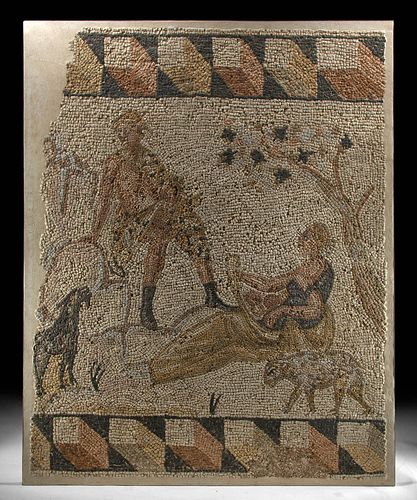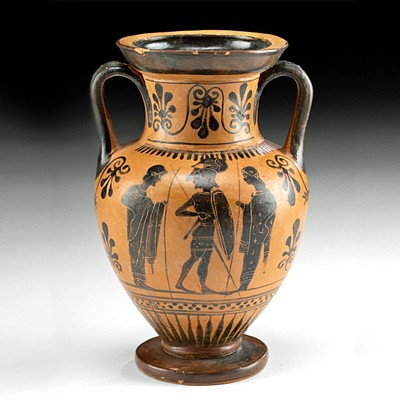Huge Roman Mosaic, Bacchus and Ariadne
About Seller
686 S Taylor Ave, Ste 106
Louisville, CO 80027
United States
Selling antiquities, ancient and ethnographic art online since 1993, Artemis Gallery specializes in Classical Antiquities (Egyptian, Greek, Roman, Near Eastern), Asian, Pre-Columbian, African / Tribal / Oceanographic art. Our extensive inventory includes pottery, stone, metal, wood, glass and textil...Read more
Two ways to bid:
- Leave a max absentee bid and the platform will bid on your behalf up to your maximum bid during the live auction.
- Bid live during the auction and your bids will be submitted real-time to the auctioneer.
Bid Increments
| Price | Bid Increment |
|---|---|
| $0 | $25 |
| $300 | $50 |
| $1,000 | $100 |
| $2,000 | $250 |
| $5,000 | $500 |
| $10,000 | $1,000 |
| $20,000 | $2,500 |
| $50,000 | $5,000 |
| $100,000 | $10,000 |
| $200,000 | $20,000 |
About Auction
Mar 9, 2023
Artemis Fine Arts info@artemisfinearts.com
- Lot Description
**First Time At Auction**
Roman, Eastern Mediterranean, Imperial Period, ca. 2nd to 4th century CE. A magnificent mosaic exhibiting a pastoral scene of a male and female - likely Bacchus, the god of wine, and his wife Ariadne during their first encounter- caught in a moment of passion, all delineated in vibrantly colored stone tesserae. The captivating scene displays a woman laying semi-recumbent and covered in a blanket as she gazes up towards her male companion, who stands above her cloaked in a leopard skin, a traditional attribute of Bacchus. The reclining beauty lifts her blanket with one hand, revealing a gathering of fruits - likely a symbol of fertility - and inviting her partner to join her. Leaning on a rock, the young man looks off in the opposite direction, keeping guard for any onlookers, while he raises his leopard hide, preparing to partake in their sensual encounter. Size of mosaic: 45.2" W x 61.7" H (114.8 cm x 156.7 cm); of frame: 48.5" W x 64.25" H (123.2 cm x 163.2 cm)
This tantalizing romance is surrounded by a rocky mount to the left and a flowering tree sprouting from the right corner and spreading its branches above the young woman, serving as another metaphor of fecundity. Our main characters are also joined by 2 animals - a hunting dog in the lower left near the male and a lamb in the lower right next to the female, perhaps serving as a symbolic reflection of the couple - the standing active male as the hunter and the lying female as the innocent lamb. The scene is additionally flanked by a lovely geometric border, featured above and below.
Leopard skins, like the one seen in this example, were typically associated with Bacchus (Greek Dionysos or Dionysus) and his followers. Bacchus was the great Roman god of wine, vegetation, pleasure, and festivity, and was the deity to which the Romans dedicated their festival of drunken revelry known as Bacchanalia. Though a prominent subject in Roman art, he was not always depicted in the same manner. The Romans typically characterized him as an elderly man with a lengthy beard or an attractive, effeminate, long-haired youth - as seen here. His attributes typically included the thyrsus (a long staff topped with a pinecone), a drinking cup, a leopard or panther skin like the figure in this example, and a fruiting vine. Thus, these 2 lovers may very well be Bacchus and Ariadne, who was traditionally depicted lying semi-recumbent like this woman. According to mythology, Bacchus first saw Ariadne, a Cretan princess, while she was sleeping and instantly fell in love. He then took her to Olympia and married her, presenting her a crown which would later become a constellation in the sky. After marrying Dionysos, Ariadne became the mother of Oenopion, the personification of wine, Staphylus, who was associated with grapes, as well as Thoas, Peparethus, Phanus, Eurymedon, Phliasus, Enyeus, Ceramus, Maron, Euanthes, Latramys, and Tauropolis. Depictions of the mythological couple are a popular motif throughout art history, spanning from black- and red-figure painting on the pottery to Ancient Greece to paintings by Titian and Tintoretto in the Italian Renaissance.
Mosaics (opus tesellatum) are some of our enduring images from the Roman world, not only for their aesthetic beauty, but also because they reveal what Romans chose to depict and see every day decorating their private and public spaces. In the Roman province of Syria, which encompassed most of the ancient Near East/Levant, mosaics seem to have developed as a popular art form relatively late, with most finds coming from the 3rd century CE or later. Syria was one of Rome's wealthiest provinces, but it was also far removed from Rome itself and Roman culture was overlaid on enduring cultural traditions from Hellenistic Greece and the great civilizations that came before it. For example, Antioch-on-the-Orontes (modern day Antakya, Turkey), was the capital of northern Roman Syria, and its excavations in the 1930s revealed more than three hundred mosaic pavements.
PLEASE NOTE: Due to recent increases of shipments being seized by Australian & German customs (even for items with pre-UNESCO provenance), we will no longer ship most antiquities and ancient Chinese art to Australia & Germany. For categories of items that are acceptable to ship to Australia or Germany, please contact us directly or work with your local customs brokerage firm.
Provenance: private Vero Beach, Florida, USA collection, acquired before 2003
All items legal to buy/sell under U.S. Statute covering cultural patrimony Code 2600, CHAPTER 14, and are guaranteed to be as described or your money back.
A Certificate of Authenticity will accompany all winning bids.
We ship worldwide and handle all shipping in-house for your convenience.
#177251Condition
Set in a modern honeycomb and plaster matrix - making it much lighter and easier to hang/display - with a metal frame. Fragment of a larger piece with losses of some tesserae on peripheries, as well as the upper left and lower right corners. Chips and abrasions to other tesserae in scattered areas, light encrustations, and light fading to colors of some tesserae, all commensurate with age. Otherwise, excellent with gorgeous preservation to decorative motifs and wonderful remains of most tesserae coloration.
- Shipping Info
-
All shipping is handled in-house for your convenience. Your invoice from Artemis Gallery will include shipping calculation instructions. If in doubt, please inquire BEFORE bidding for estimated shipping costs for individual items.
-
- Buyer's Premium



 EUR
EUR CAD
CAD AUD
AUD GBP
GBP MXN
MXN HKD
HKD CNY
CNY MYR
MYR SEK
SEK SGD
SGD CHF
CHF THB
THB















